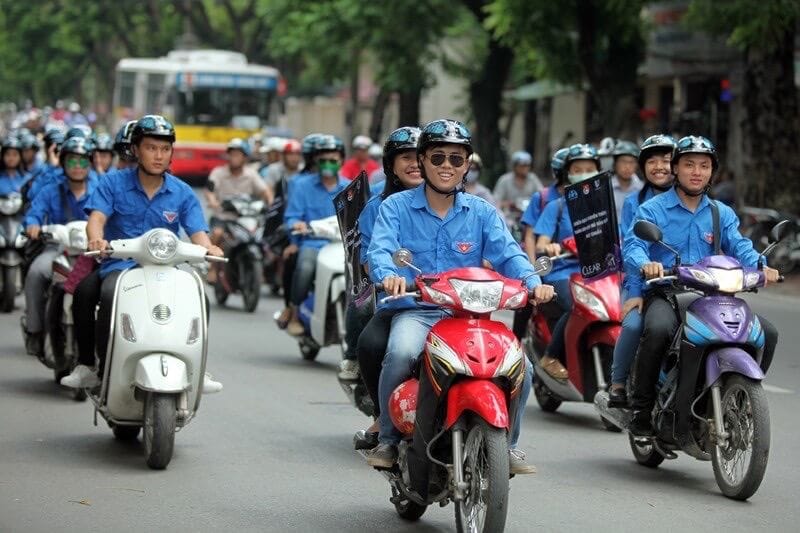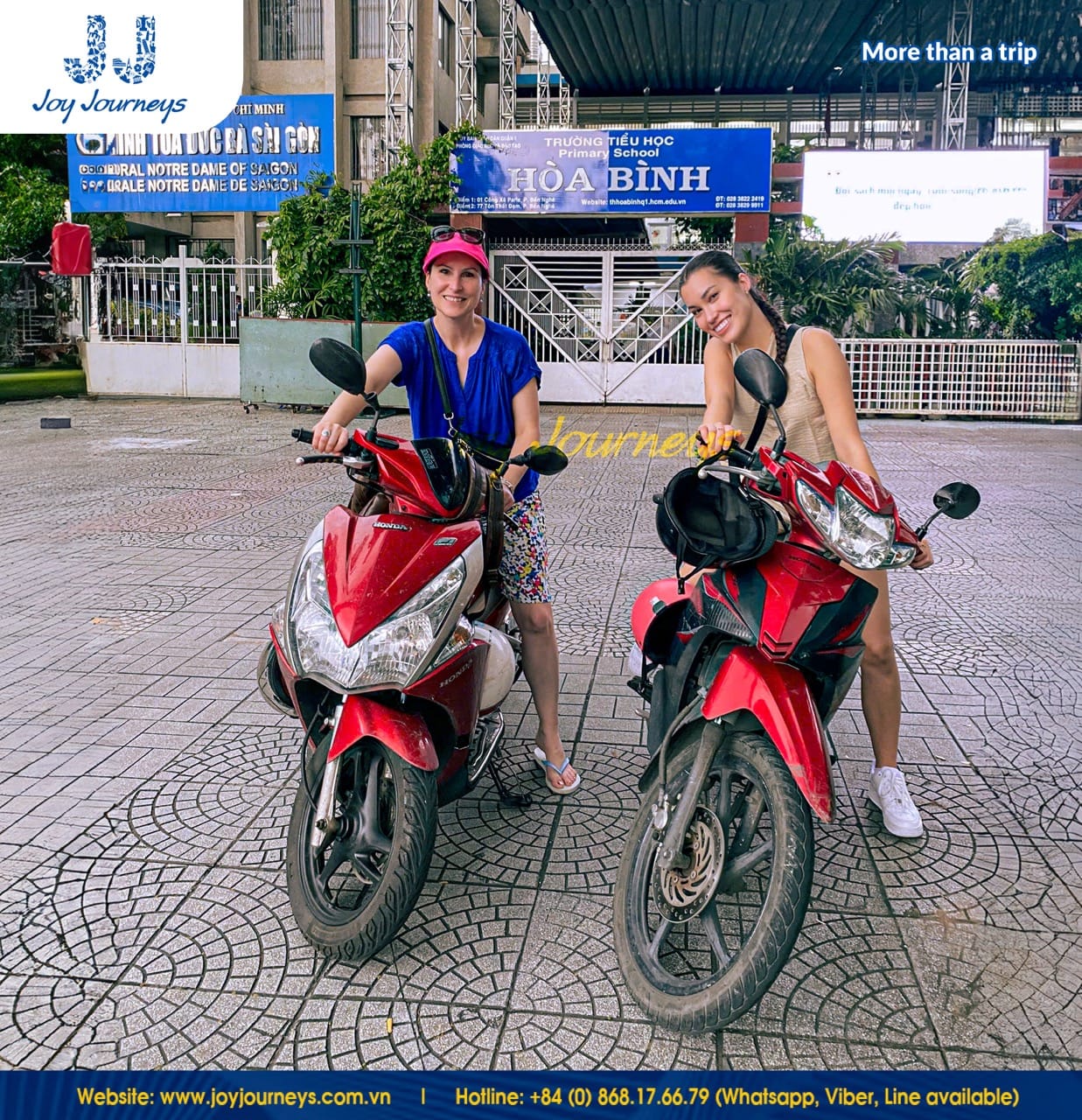With its breathtaking landscapes, rich cultural heritage, and vibrant local experiences, Vietnam offers an unforgettable adventure for motorbike enthusiasts. Discover hidden gems, meet friendly locals, and create lasting memories as you explore diverse terrains and immerse yourself in the heart of Vietnam.
Contents
Why Choose a Motorbike Adventure in Vietnam?
Freedom and Flexibility
If you love adventure and exploration, a motorbike trip in Vietnam is an experience you can’t miss. This mode of transport gives you the freedom to choose your route, the comfort to stop whenever you like, and the flexibility to manage your time as you please.

Scenic Routes
Vietnam’s breathtaking landscapes—lush rice fields, winding rivers, and stunning coastlines—are best experienced on a motorbike. Unlike traveling by car or bus, riding a motorbike allows you to fully take in the sights, sounds, and beauty of the country without barriers.
Cultural Immersion
As of September 2024, Vietnam has 77 million registered motorbikes, making it the most popular mode of transport in the country. To truly connect with the local culture and experience daily life as the Vietnamese do, a motorbike tour is a must.
Planning Your Motorbike Trip
Renting or Buying a Motorbike
For travelers seeking a temporary ride without the commitment of ownership, renting a motorbike is a practical option. Vietnam has a vast network of rental companies offering a variety of motorbikes to suit different travel needs.
Popular tourist destinations like Hanoi, Ho Chi Minh City, Da Nang, and Hoi An have numerous rental shops, making it easy to find a motorbike. Vietnam motorbike price varies depending on the type of motorbike, rental duration, and location, typically ranging from $5 to $15 per day.

Renting a motorbike in Vietnam is a straightforward process. Required documents usually include your passport and sometimes a deposit. Always ensure you receive a comprehensive rental agreement outlining terms and conditions, and thoroughly inspect the motorbike to avoid disputes. Additionally, having a basic understanding of motorbike operation and safety protocols is essential.
Obtaining a License
Under Vietnamese law, only an International Driving Permit (IDP) is valid for use in Vietnam. Other international driving licenses are not accepted. Ensure you have the correct Vietnam motorbike license before starting your journey.
Choosing Your Route
Northern Vietnam
- Start in Hanoi: Explore the city and arrange any necessary permits.
- Ride to Ninh Binh to visit Trang An or Tam Coc.
- Head to Phong Nha-Ke Bang National Park and explore its unique caves.
- Travel south to Hue, crossing the famous Hai Van Pass.
- Discover Hue’s historical sites and surrounding attractions.

Central Vietnam
- Visit the charming Hoi An Ancient Town.
- Take a side trip to My Son Sanctuary.
- Explore Da Nang, including the Marble Mountains.
- Continue south to Quy Nhon for stunning beaches and local culture.
Central & Southern Vietnam
- Enjoy the coastal scenery in Nha Trang.
- Head to Da Lat in the Central Highlands for a refreshing change of pace.
- Travel south to Ho Chi Minh City (Saigon), Vietnam’s bustling metropolis.
Southern Vietnam
- Explore Ho Chi Minh City and its historical landmarks.
- Take a day trip to the Mekong Delta for a cultural experience.
- End your epic journey back in Ho Chi Minh City, indulging in its vibrant food scene and nightlife.
Packing Essentials
Since motorbike trips involve constant movement and limited storage space, pack light and bring only essentials: Sun protection – Sunscreen, sunglasses, and lightweight clothing; Comfortable clothing – Breathable, absorbent fabrics; Footwear – Trekking shoes or light sneakers; Insect repellent – Essential for tropical areas.
Motorbike Safety and Etiquette in Vietnam
Traffic Laws and Regulations
Before embarking on a 10 day motorbike trip in Vietnam, it is crucial to familiarize yourself with local traffic laws. While regulations may differ from those in your home country, strict adherence is essential. Vietnam enforces a mandatory helmet law, requiring both riders and passengers to wear helmets.

Understanding traffic signs and signals is equally important, as they may not align with the conventions you’re used to. Be especially mindful of speed limits, directional signs, and road condition warnings.
Vietnam’s road culture differs significantly from Western norms. Be aware of common practices such as:
- Vehicles driving on the wrong side of the road.
- Sudden lane changes without signaling.
- Overtaking on narrow or winding roads.
Staying alert and anticipating such behaviors will help you ride more safely.
Road Conditions and Hazards
- Plan your route strategically: Whether riding through bustling cities or rural landscapes, careful planning is essential. GPS navigation apps can help, but memorizing major landmarks and intersections will also make navigation smoother.
- Avoid rush hour: Cities like Hanoi and Ho Chi Minh City experience severe congestion during morning and late afternoon rush hours. If possible, schedule your rides outside these peak times to minimize delays and potential hazards.

Cultural Sensitivity
Navigating the dense urban traffic of Vietnam can be overwhelming, particularly for first-time riders. The following tips will help you manage the fast-paced, unpredictable traffic:
- Stay calm and patient: Vietnam’s roads are a mix of motorbikes, cars, bicycles, and pedestrians moving in seemingly chaotic flows. Remaining patient and composed is key to safe riding.
- Follow local traffic patterns: Observe how local drivers navigate through traffic. Many use hand signals rather than blinkers, so paying close attention to these gestures can help you predict their movements.
- Use your horn wisely: In Vietnam, honking is commonly used to signal your presence rather than express frustration. However, excessive honking should be avoided, as it contributes to noise pollution and may irritate other road users.
Vietnam Motorbike Tours
Guided Tours vs. Independent Travel
Exploring Vietnam by motorbike offers two distinct experiences: guided tours and independent travel. Guided tours provide a safer and more convenient journey, ensuring you don’t get lost while also offering valuable insights about the places you visit.
On the other hand, independent travel allows for greater flexibility, giving adventurers the freedom to explore at their own pace. When considering your options, it’s important to also explore Vietnam motorbike tours prices to find the best fit for your budget and preferences.
Benefits of Guided Tours
Opting for a guided motorbike tour ensures a hassle-free experience. Tour providers handle the itinerary, select scenic routes, and take care of logistics, allowing travelers to simply enjoy the ride. With expert guides leading the way, tourists can focus on the journey without worrying about navigation or planning.
Joy Journeys’ Motorbike Tours
Joy Journeys currently offers the Private Saigon “Foodie” By Night Motorbike Tour, an exciting way to experience the vibrant nightlife of Ho Chi Minh City. Combining a motorbike adventure with a culinary exploration, this tour immerses travelers in local life, allowing them to savor authentic Vietnamese street food while taking in the city’s bustling atmosphere.
See details at https://joyjourneys.com.vn/

Frequently Asked Questions
What are the motorbikes in Vietnam called?
In Vietnam, motorbikes are referred to as “xe máy.”
Can foreigners ride a motorbike in Vietnam?
Yes, foreigners can ride a motorbike in Vietnam if they possess a valid International Driving Permit (IDP) or obtain a temporary Vietnamese motorbike license.
Why are motorbikes so popular in Vietnam?
Motorbikes are widely used in Vietnam due to their affordability, practicality, and ability to navigate heavy traffic, especially on narrow streets. They are the primary mode of transportation for many locals.
What is the most popular motorcycle in Vietnam?
Honda is the most popular motorbike brand in Vietnam. Among its models, the Honda Wave and Honda Blade are particularly favored for their reliability, fuel efficiency, and affordability.
Conclusion
Experience the freedom of a Vietnam motorbike journey, where scenic roads, vibrant cultures, and hidden gems await. Ride through lush fields, bustling cities, and coastal paths, embracing Vietnam on two wheels. Plan your unforgettable adventure today!


Related Posts
Experience the Living Conditions in Cu Chi Tunnels: Unbelievable!
Cu Chi Tunnels served as the living quarters for soldiers and civilians during Vietnam’s resistance against France and America. Today, this remarkable site stands as a symbol of perseverance, determination, and resilience during one of the most challenging periods in Vietnamese history. Discover the living conditions in Cu Chi Tunnels with Joy Journeys in the […]
Vietnam Fish Cake: A Culinary Delight
Vietnam fish cake, known for its delicious and diverse flavors, is a favorite among tourists looking to explore authentic Vietnamese cuisine. From the crispy, golden-brown texture of fried fish cakes to the fragrant, herb-infused variations found in regional specialties, these savory delights offer a true taste of Vietnam. In this article, we will take you […]
Food and Supplies in Cu Chi Tunnels: Survival Underground
The tunnel system at Cu Chi Tunnels is a testament to the ingenuity, perseverance, and indomitable will of the Vietnamese army and people during nearly 30 years of fighting. Beyond serving as a shelter, this intricate network evolved into a vital transportation and communication route for the soldiers. Joy Journeys offers an in-depth exploration of […]